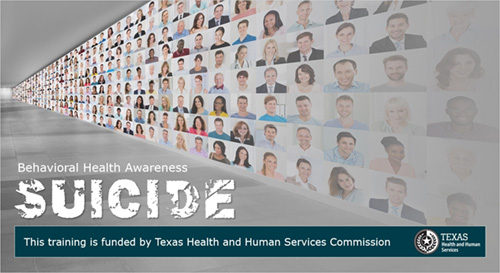If you or someone you know is in crisis right now, call 911, go to the nearest hospital, or call the National Suicide Prevention line by dialing 988 for both English and Spanish. If you are a veteran, press 1. People who are deaf, hard of hearing, or have hearing loss can contact the Lifeline via TTY by dialing 711 and then 988. There are people willing and ready to help you or your loved one.
Suicide attempts are not driven by a single motivation for everyone. For some, suicide is seen as the only solution to chronic emotional or physical pain. Other times, a person may feel overwhelmed and unable to resolve negative life events. For others, a suicide attempt may be a means of communicating to others their severe suffering and the seriousness of their need. Many times, a person who is contemplating suicide is living with a mental health condition, such as depression or bipolar disorder. All suicide attempts should be taken seriously, and appropriate help should be sought for the person.
Suicide is on the rise globally, accounting for nearly one million deaths annually. The suicide rate has increased by over 30% in the last 20 years, and in 2016, suicide became the 2nd leading cause of death among ages 10-341. Over the past decade, the rates of children hospitalized for suicidal thoughts or behaviors have doubled.
These rising suicide rates call on each of us to pay closer attention to how the people we know and love are coping with life. Just because someone’s life appears to be good on the outside doesn’t mean all is well in their more private moments.
Suicide Warning Signs
Can include statements like:
- “I want to kill myself”
- “I wish I were dead”
- “I feel hopeless”
- “There’s no reason to live”
- “I just want the pain to end”
- “I’m too much of a burden”
- “I feel trapped”
Can include behaviors, such as:
- Seeking access to means to kill oneself (pills, weapon)
- Increased use of alcohol or drugs
- Giving away prized possessions
- Calling others to say goodbye
- Talking or writing about death
- Isolating from others
- Withdrawing from activities
- Researching ways to die by suicide
If you notice that someone is saying statements like these or starting to engage in these behaviors, it is important to ask them about how they are doing. Starting an open conversation and asking directly if someone is thinking about killing themselves does not increase the chances someone will attempt suicide and it could save their life.
Learn important information on how to help someone who may have suicidal thoughts or feelings. Download the suicide prevention wallet card (PDF) which identifies warning signs, specific steps to help someone and resources to get help.
For more information about Suicide and resources for suicide prevention, visit:
- Texas Health and Human Services to find your Local Mental Health or Behavioral Health Authority and corresponding crisis centers.
- Texas Suicide Prevention for suicide prevention resources (trainings, apps, other resources) in Texas.
- The Trevor Project for crisis resources specifically for the LGBTQ+ community.
- National Institute of Mental Health for statistics on suicide.
Language Matters
Discussing suicide in a neutral and factual manner decreases stigma and encourages others to open up about suicide. Download English version: Language Matters: Talking About Suicide (PDF) Spanish version: Language Matters Talking About Suicide – Spanish.pdf. For more information about speaking about suicide in a safe and caring manner.
Postvention
Postvention describes the response provided to individuals and communities to promote hope and healing after a suicide death. To learn more about safe postvention practices download English version: download Postvention (PDF). Spanish version: Postvention-Spanish.pdf.
Compassion Fatigue
Compassion fatigue is real and affects people working in the mental health field. Combating compassion fatigue is an important part of suicide prevention. Learn more about the symptoms of compassion fatigue by downloading English version: Compassion Fatigue (PDF). Spanish version: Compassion Fatigue-Spanish.pdf.
Parent and Youth Suicide Prevention
It is important for parents to know how to talk to their youth about suicide prevention. To learn about connecting with youth to discuss thoughts of suicide, download the English version: Youth Suicide Prevention (PDF). Spanish version: Youth Suicide Prevention-Spanish.pdf.
Teacher and Youth Suicide Prevention
It is important for school personnel to know how to talk to students about suicide prevention. Learn how to connect with students by downloading the Teacher suicide prevention PDF English version: Teacher Youth Suicide Prevention (PDF).pdf. Spanish version: Teacher Youth Suicide Prevention-Spanish.pdf.
Older Adult Suicide Prevention
Discussions about mental health and checking in with older adults who have experienced a significant loss is important. To learn more, download the Mental Health in Older Adults (PDF) informational flyer (Spanish https://www.hhs.texas.gov/sites/default/files/documents/salud-mental-en-adultos-mayores.pdf)
Care Transitions for People Receiving Suicide Crisis Services
During transitions in care, it is critical for caring professionals, family and friends to maintain contact with the person in care. To learn more, download the Transitions in Care for People Receiving Suicide Crisis Services (PDF) informational flyer. (Spanish: https://www.hhs.texas.gov/sites/default/files/documents/transitions-in-care-for-people-receiving-suicide-services-es.pdf)
Suicide Prevention for People with Intellectual and Developmental Disabilities
People with Intellectual and Developmental Disabilities also have thoughts of suicide. To learn more, download the Suicide Prevention for Individuals with IDD informational flyer (PDF). Spanish (https://www.hhs.texas.gov/sites/default/files/documents/idd-suicide-prevention-flyer-esp.pdf)
Survivors of Suicide Loss
Grieving someone who died by suicide brings unique challenges as the person who died seems to have chosen death. To learn more, download the Survivors of Suicide Loss (PDF) informational flyer. (Spanish: https://www.hhs.texas.gov/sites/default/files/documents/survivors-of-suicide-loss-flyer-es.pdf)
If you experience difficulty accessing care or if you’re having issues with your health plan, the Texas Department of Insurance and the Texas Health and Human Services Commission’s Office of the Ombudsman might be able to help. They can also help you learn more about your rights.
Sources
- CDC: NCHS Data Brief No. 309, June 2018
https://www.cdc.gov/nchs/products/databriefs/db309.htm

Learn more about Suicide and other behavioral health conditions at our eLearning Hub. The quick, informative courses are designed to equip you with knowledge, resources, and hope for the future – for yourself or for someone else you care about.
